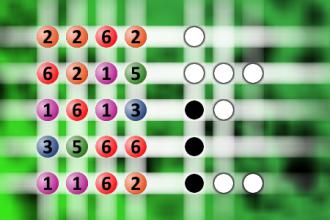What a winning combination?
The computer chose a secret code (sequence of 4 digits from 1 to 6). Your goal is to find that code. Black circles indicate the number of hits on the right spot. White circles indicate the number of hits on the wrong spot.Correct answers: 22
The first user who solved this task is Nasrin 24 T.
#brainteasers #mastermind

The 6th grade science teacher...
The 6th grade science teacher, Mrs. Parks, asked her class, "Which human body part increases to ten times its size when stimulated?"
No one answered until little Mary stood up and said, "You should not be asking sixth-graders a question like that! I'm going to tell my parents, and they will go and tell the principal, who will then fire you!"
Mrs. Parks ignored her and asked the question again, "Which body part increases to 10 times its size when stimulated?"
Little Mary's mouth fell open. Then she said to those around her, "Boy, is she going to get in big trouble!"
The teacher continued to ignore her and said to the class, "Anybody?"
Finally, Billy stood up, looked around nervously, and said, "The body part that increases 10 times its size when stimulated is the pupil of the eye."
Mrs. Parks said, "Very good, Billy," then turned to Mary and
continued. "As for you, young lady, I have three things to say: One, you have a dirty mind. Two, you didn't read your homework. And three, one day you are going to be very, very disappointed."
No one answered until little Mary stood up and said, "You should not be asking sixth-graders a question like that! I'm going to tell my parents, and they will go and tell the principal, who will then fire you!"
Mrs. Parks ignored her and asked the question again, "Which body part increases to 10 times its size when stimulated?"
Little Mary's mouth fell open. Then she said to those around her, "Boy, is she going to get in big trouble!"
The teacher continued to ignore her and said to the class, "Anybody?"
Finally, Billy stood up, looked around nervously, and said, "The body part that increases 10 times its size when stimulated is the pupil of the eye."
Mrs. Parks said, "Very good, Billy," then turned to Mary and
continued. "As for you, young lady, I have three things to say: One, you have a dirty mind. Two, you didn't read your homework. And three, one day you are going to be very, very disappointed."

